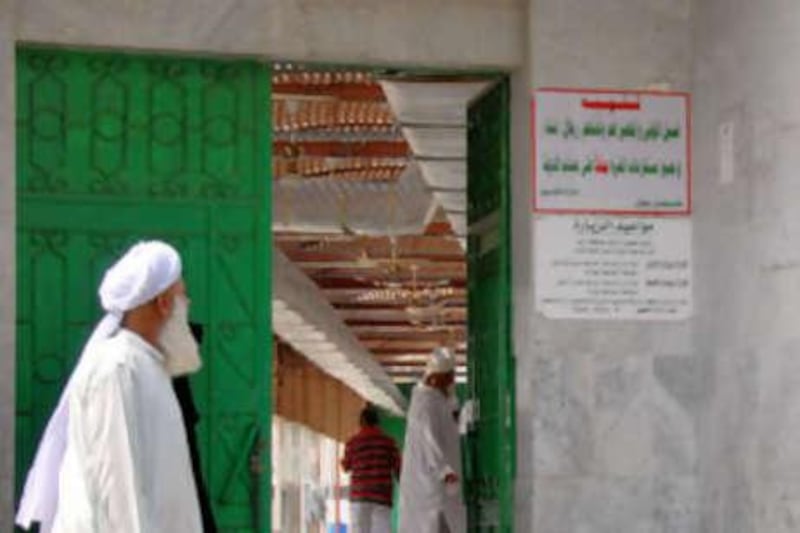In one of the oldest neighbourhoods in Jeddah lies a legend as old as time itself and one that is crumbling away into oblivion - the tomb of biblical Eve. As the holy month of Ramadan enters its final days, some Saudi families in Jeddah will be visiting the graves of their loved ones as part of their Eid tradition that revolves around love, joy and kinship - with one particular mother remembered along with the rest. "My mother's grave lies in the same cemetery as that of the mother of all humanity, Hawa [Eve]," said Sami Nawar, the general director for culture and tourism in Jeddah. For the sceptics, there is an actual sign marking "Our Mother Eve" graveyard hanging on the main green metallic gate of one of the oldest cemeteries of Jeddah in the heart of the Al Balad neighbourhood. Mr Nawar is from one of hundreds of Saudi families that have relatives buried in "mother Eve's graveyard", and he takes it upon himself to inform Saudi visitors to this site, keeping the "legend" alive even in the absence of scientific proof. "Famous Arab travellers like Ibn Battuta and historians that have passed through here hundreds of years ago and even some of Prophet Mohammed's companions have made reference to Eve's tomb in this area," said Mr Nawar, who explains that the name of the city itself - Jeddah - if pronounced a certain way, means "grandmother". "And who is the grandmother of everyone?" he said, unable to hide his enthusiasm for the legend."If it is a lie, then it is a thousands of years old lie," he said. Mr Nawar figures the tomb was 120 metres long, three metres wide and six metres high - that is before it began to fall apart through the centuries. "It is a shame, all we have now is its location, the main gate and stories of its existence," he said, dating the last pieces of the tomb's skeleton to the 1920s. The common legend that Eve was more than a 100 metres tall is unlikely, according to Mr Nawar, who said he has an old photo showing that inside the large tomb was an average-sized tomb. "I am still researching this, it is hard given that there is no one alive who remembers the tomb as it was [from the 1920s]," he said. The Quran, like the Bible and Torah, tells the story of Adam and Eve and how they were expelled from Paradise after disobeying God by eating the forbidden fruit. There is no mention of where they ended up on earth, but according to Arab tradition, it is believed that Adam and Eve led separate lives. Adam went to Makka, 70km away from Jeddah, where God ordered him to build the Kaaba, the sacred black rock that Muslims around the world face during their five daily prayers; while it appears Eve lived in the area known now as Jeddah, the entry point for pilgrims heading to Makka. "There is no definite way of knowing where exactly the tomb is, as some say it is somewhere in Palestine and others say it in Saudi Arabia, who knows," said Frauke Heard-Bey, a German-British historian, published author and an expert on the Gulf. Ms Heard-Bey, along with other experts, explained that part of the problem of finding any conclusive evidence about the tomb of Eve in Saudi is in their manner of maintaining historic sites and monuments, where the strict Wahhabi doctrine forbids the maintenance of artefacts because this could lead to "shirk" - polytheism - associating any other figure with God. "Based on what they saw happening in other religions and with the Shiites, where a revered person is turned into a saint once dead, Wahhabism eliminated any chances of that happening by having unmarked graves," Ms Heard-Bey said. Tombs, objects and homes of venerated people - whether historic or religious - are destroyed because "they [Wahhabists] don't want anything to intrude between the relationship of the worshipper with God", she said. Sami Angawi, an architect and historian in Saudi Arabia who has been a long-standing critic of the lack of preservations of historic artefacts and monuments, agreed with Ms Heard-Bey. "Tombs are not preserved in Saudi Arabia and visiting graves is not encouraged as Wahhabists believe that they could lead to Bedaa [a frowned upon invention that undermines the orthodoxy of Islam] and eventually to shirk." Mr Angawi said "systematically", over the past 80 years, historic artefacts and sites have been cleared off because of the strict Wahhabi doctrine and for the sake of expansion for the pilgrims whose numbers are increasing each year. "Eve's tomb is now just a flat hole among a graveyard of unmarked tombs," he said. "It was left to deteriorate, and all we have left is the legend, which will live on and be passed on to the next generations," he said. rghazal@thenational.ae
In unmarked Saudi tomb lies 'grandmother of everyone'
In one of the oldest neighbourhoods in Jeddah lies a legend as old as time - the tomb of biblical Eve.

Editor's picks
More from the national




